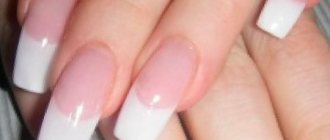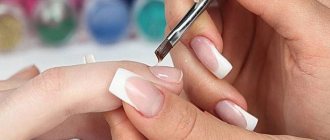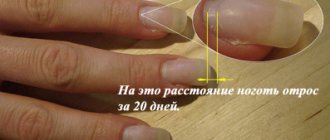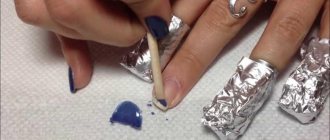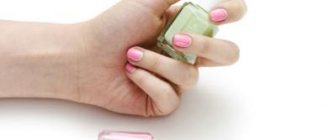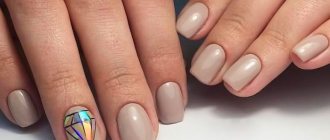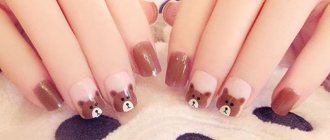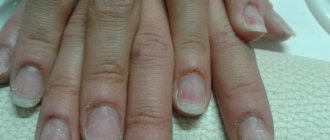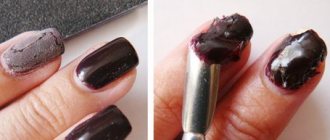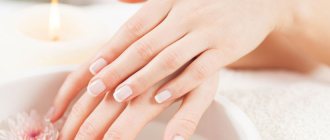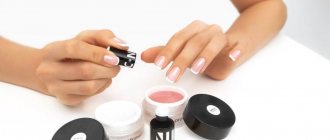Gel nails are a convenient solution for women who do not have enough time and patience for frequent manicures, but who want to have beautiful, well-groomed nails and a flawless appearance. However, sometimes situations arise when they need to be removed. We'll talk about what these reasons are and how to remove extended gel nails at home on your own and without the help of a professional nail technician.
Reasons for deletion
Gel, acrylic or other artificial nails must be removed periodically to allow regeneration and restoration of the natural nail plate. It happens that cosmetics manufacturers do not take this need into account, but if you neglect it, you will soon see that the extended nails no longer look attractive, and your own nails are very damaged. Subsequently, several weeks of intensive medical therapy may be required to restore and strengthen them.
Sometimes it happens that gel nails are subject to mechanical damage, which can cause them to break or peel off along with the natural nail plate.
Peeling gel nails
There are several important reasons why you have to get rid of them:
- Suspicion of significant destruction of the native nail due to continuous wearing of gel nails for months.
- Pregnancy and hormonal disorders that cause too high levels of moisture in the nail plate.
- Nail diseases, such as fungus.
Pregnancy, disorders and hormonal imbalances in the body can cause poor adhesion of the gel mass to the surface of the nail plate. The gel applies and sticks very poorly if it is too wet or oily. In turn, applying it if you have nail diseases will, for obvious reasons, harm them even more.
You can remove gel nails yourself at home, or by contacting a specialist in a beauty salon. In the second case, you will have to pay a decent amount for the procedure, so if you do not want to waste time and money, then you can get rid of the gel yourself. How to do this correctly and how to then care for your nails in order to restore them, we will look a little further.
Errors when removing the coating
Incorrect removal technique can quickly damage the natural nail. Common mistakes when removing artificial turf that can cause harm:
- Biting and picking at extended nails.
- Strong pressure on the router handle when using hardware removal.
- Using low-quality cutters for the machine.
- Filing the coating together with the natural nail.
- Using highly abrasive files when processing natural nails.
- Elimination of further care.
How to properly remove gel nails yourself at home
The procedure for removing gel nails is quite complicated and troublesome. Unlike regular varnish, it cannot be removed using special solvent liquids. To do this you will need to use some tools.
You will need the following materials:
- Manicure tweezers.
- A file with a high abrasiveness coefficient, for example, 80/100, is perfect.
- Polishing buff file.
- Cotton pads.
- Acetone.
- A brush is required to easily remove gel dust.
- It is advisable to have glasses to protect your eyes, since during the procedure pieces of the gel and its small abrasive particles can fly into the eyes and injure the mucous membrane.
Stages of the procedure
- Take the tweezers and carefully trim the free edge of the gel nail. Be careful not to touch the original nail plate. This step is mandatory and only after it can you begin to remove the gel.
- Carefully and thoroughly file away the gel with a nail file. During the process, a lot of dust may arise, so periodically shake it off using a brush. Try not to damage your natural nails, otherwise you will have to spend a lot of time restoring them.
- Apply acetone to a cotton pad and rub it over the nail to reveal the boundary between the extensions and the natural nail.
- At the end of the procedure, polish the nail plate with a polishing file.
- Repeat all previous steps for all nails.
In the video you can see in detail how to remove gel nails. Repeat all the steps after the wizard, and you will be surprised that, it turns out, there is nothing difficult in removing them. But by carrying out the procedure yourself at home, you will save a considerable amount.
Acrylic nails
Acrylic nails are easier to remove yourself than gel nails. Firstly, it is faster, and secondly, it is safer. Materials you will need:
- medium hard nail file;
- manicure spatula;
- nail polish remover;
- foil;
- cotton pads;
- a piece of suede or a delicate file for polishing nails.
Step-by-step instructions for removing acrylic nails:
- Remove the top coat of acrylic nails with a nail file - its layer is usually very thin;
- Soak cotton pads in acetone, apply to the nail and secure with foil. Foil is an impenetrable material: acetone will not evaporate through it, and you will not breathe it again;
- After 15 minutes, rub a test nail with the same disk - if the acrylic comes off, you can do the same with the rest of the nails;
- Remove the softened acrylic using a manicure spatula;
- Use a suede or a delicate file to polish your nails and file them.
How to care for damaged nails after removing extensions
After you remove your gel nail extensions, you will find that your own nails are in very poor condition. That’s why they need treatment and recovery. The best way to ensure this is to go to a beauty salon, where you will receive professional care. It has an undoubted advantage over home methods, primarily due to the availability of a professional range of care products and tools, as well as the experience and knowledge of a specialist.
Oil baths to restore and strengthen nails
However, if for some reason this is not possible, you can treat damaged nails yourself at home. Once a week or even every other day, make a hand bath with olive or flaxseed oil. Nails are damaged, and the fastest and most effective way to return them to their proper condition is through oil treatments. During the treatment bath, you should gently massage the area around the nail to stimulate its growth. Due to frequent contact with oils, creams and other cosmetics, you should forget about varnishes at first.
Eating vitamins and other beneficial substances is an important part of nail care. You can purchase special medicinal preparations for nails, or buy vitamins in ampoules and rub them into the nail plate. Don't forget about your diet. Care should be taken that it includes a sufficient dose of all substances necessary for the body. This will speed up the process of restoring damaged nails after removing the extensions.
The speed at which damaged nails return to their proper condition depends on the intensity of their care and adherence to a proper diet, including all the necessary vitamins and minerals. It is especially important to pay them as much attention as possible at the initial stage of treatment.
Preparation
Preparation is the very first stage of removing manicure extensions. In this case, the free edge of each nail is removed. But, as written above, you should not make the cut too short. Leave a length of about a millimeter to avoid damaging your natural nails and the skin around them.
The easiest option for trimming the free edge is to use a tip cutter . This is a special tool used by manicurists, similar to nail clippers for trimming pet nails.
@mastershop_kz
If you don’t have a tip cutter in your arsenal, you can use regular tongs (nippers) included in a standard manicure set.
@artstilopt.ru
Carry out the procedure very carefully and carefully so as not to damage the natural nail. The coating is removed only after each nail has been trimmed to its minimum length.
Manicure after gel nails
After removing the gel mass, you will see that your nails look unsightly, so it’s worth doing a fresh manicure. However, without the use of varnishes and other coatings. It should be done on polished nails. To do this, it is better to use a glass file, and at the same time use it to give the nail plate the correct shape and shorten it, if necessary.
A good solution would be to do a gentle biological manicure , which begins with a regenerating bath for hands and nails with the addition of oils that contain a large amount of nutrients. After softening the skin and if there are no contraindications in the form of damage to the epidermis, you can also do a gentle peeling.
Biological manicure
To soften the cuticle and make it easier to remove with a wooden spatula, apply a special preparation to it. If the nails are severely damaged, and the skin of the hands requires deeper nutrition and regeneration, then the next step is to use a mask, serum or nourishing oil. It is recommended to massage the selected product into damaged nail plates.
To achieve the best result, you should immediately take a paraffin bath afterwards. This will cause the beneficial substances to be sealed under an impenetrable layer of paraffin, and the increase in temperature will enhance their penetration into the skin. After completing the procedure, apply a nourishing cream high in vitamins and other beneficial substances to the skin of your hands. And on the nails, depending on their condition, the regenerating substance is applied in the form of oil. After a biological manicure, do not paint your nails. Using conditioner is also worth waiting for, as they have an oil film that nourishes them.
As you can see, removing gel nails yourself at home is not that difficult. However, do not forget that after the procedure your loved ones need recovery and strengthening, and therefore it will be necessary to provide proper care for them.
Removal by filing
If you do not have a manicure machine, you can remove extended nails using a nail file. The method is suitable for all types of artificial turf grown on forms. To do this, use a tool with an abrasiveness of 60-80 grit. Such a hard file is necessary to remove the main coating.
It is recommended to move the file in one direction.
When approaching a natural nail, change the file to 100-180 grit. When the natural nail becomes visible, the removal of the coating is complete. Finish processing with a buff. It has an abrasiveness of up to 400 grit, which does not injure the natural plate, but removes the remains of the artificial coating.
Type of technology
Before removing extended nails, you need to find out what extension technologies exist. There are 5 types of them:
- Acrylic system. This method makes nails stronger and more elastic. They are quite thin, so they look very natural.
- Gel. This manicure has a beautiful glossy shine. This type of extension should be chosen by girls who have a soft natural plate by nature.
- Glue powder. A fairly fast way to build up. The manicure turns out matte, it resembles porcelain. This method involves the use of standard blanks.
- Fabric technology. To create such a manicure, you need fabric (fiberglass, silk). You won't be able to increase the length this way. The technology is used to repair acrylic or gel nails, or to strengthen the natural plate.
- Combination of gel and acrylic. This manicure is very durable and looks incredibly impressive.
- Gel polishes. This method was invented quite recently. It differs in that it is gentle on natural nails, strengthening them for a very long period (2-3 weeks). A very convenient and quick way to create a manicure.
Each of the procedures includes a polymerization reaction, that is, thickening of various materials. This allows you to make your nails incredibly strong. But to remove such a manicure, you will need time and certain materials.
